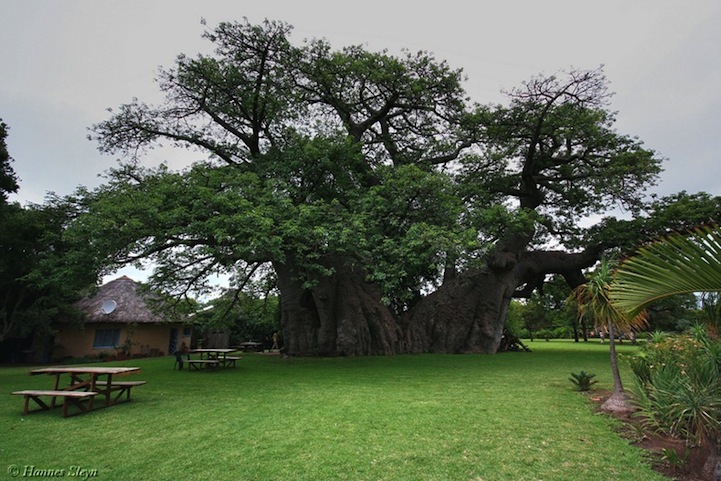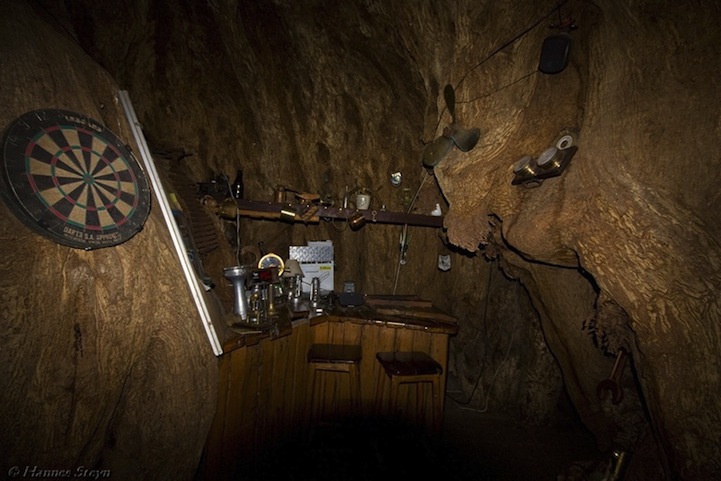🌳 An Unforgettable Marvel of Nature and Hospitality
On Sunland Farm, nestled in the rolling hills of Limpopo Province near Modjadjiskloof, South Africa, stood a singular wonder of both nature and human ingenuity. Known variously as the Sunland Big Baobab, Platland Baobab, or colourfully as “Tree Bar” or the “Pub Tree”, it was a living legend: an enormous hollowed baobab tree containing within its colossal trunk a fully‑functioning pub and wine cellar.
Celebrated across travel guides and ecological journals alike, the Big Baobab was carbon‑dated to ages as high as 6,000 years, a claim that made it older than the pyramids. Although some scientific studies suggested a more conservative age of around 1,060 ± 75 years, its sheer scale—22 m high, 47 m in circumference, trunk diameter 10.64 m—made it one of Africa’s largest and most ancient baobabs (Wikipedia).
The Age‑Old Mystery: Carbon‑Dating the Giants
Baobabs (Adansonia digitata) are famed not only for their gargantuan size but also their astonishing longevities. Traditional methods of tree‑ring age estimation are impossible—baobabs often hollow out internally and lack clear annual rings. Scientists therefore rely on Radiocarbon dating of wood samples taken from inner cavities.
In a landmark 2011 study, researchers from Babeş‑Bolyai University and collaborators analysed the Platland tree’s stems. Stem I was dated at approximately 750 ± 75 years, while stem II yielded 1,060 ± 75 years. The complex branching hinted that one stem had fused into another some four centuries ago (BioMed Central). Yet anecdotal claims placed the tree’s age at 6,000 years, likely reflecting an over‑interpretation of local lore and older sampling results (My Modern Met).
Whether millennia or simply a millennium old, the tree stood as a monument: a living vessel of centuries of fire, wildlife, travel, and human cultural imprint.
Birth of the Tree Bar: From Hollow to Hangout
In 1993, owners Doug and Heather van Heerden transformed the tree’s interior into a pub and wine cellar. After clearing away compacted organic matter to reveal a floor roughly one metre below ground, they built a rustic bar inside the larger hollow, complete with wooden benches, draft beer, lighting, a music setup, shelves of memorabilia—and even a dart game on the interior wall. A secondary hollow became a wine cellar held at around 22 °C, courtesy of the tree’s natural ventilation (Wikipedia).

With ceilings soaring to some 13 ft (approximately 4 m), the interior could comfortably seat about 15 people. At times, up to 40 or even 60 attendees crammed inside for special events—testament to both the tree’s size and the owners’ convivial spirit (Earthly Mission).
A Tourist Sensation in the Limpopo Bush
The pub quickly became a must‑see attraction on South African travel itineraries. Visitors described the experience as equal parts awe‑inspiring and whimsical: sipping a pint within the walls of a living organism older than civilisation. Guides by Atlas Obscura, My Modern Met, Earthly Mission and other niche outlets relayed how global tourists flocked to the Duiwelskloof region to experience the marvel firsthand (Atlas Obscura).
Accommodation in the form of quirky “Jungalows” on the Sunland Farm allowed overnight guests to enjoy a full safari‑meets‑pub weekend. Combined with hikes, bird‑watching (the tree once sheltered owls), and South African hospitality, the experience blended culture and ecology seamlessly (Atlas Obscura).
The Decline: When Ancient Giants Fall
Unfortunately, the story of the Big Baobab would end in tragedy. As the global study published in Nature Plants in 2018 noted, many of Africa’s oldest baobabs had collapsed or died between 2005 and 2017. Nine of the 13 oldest and five of the six largest trees were affected (The Washington Post).
In August 2016, a major split fractured one third of the Sunland tree. A previous break had occurred in 2014. The damage was attributed to age‑related decay—hollowed interiors, weakened stems—and possibly environmental stressors brought on by drought and climate change (Wikipedia).
Though parts of the tree and the bar remained intact until as late as 2019, reports described it as dilapidated—its interior gradually succumbing to rot, insects, and structural collapse. Eventually, the bar closed as the tree lost integrity (Atlas Obscura).
By mid‑2025, the site was permanently closed to visitors; the iconic pub no longer in operation and the tree unsafe. Its demise served as a sombre symbol of ecological fragility and the loss of natural heritage.
Ecology, Culture & Conservation: The Baobab’s Broader Tale
A Tree of Trees
The African baobab is unique among flora: its trunk can hold thousands of litres of water, its fruit is edible, bark used for rope and medicine, and its hollows offer refuge to animals and humans alike. A single tree may host colonies of insects, birds (including owls), and even serve as a shelter in storms (Wikipedia, Atlas Obscura).
Climate Crisis and Ancient Trees
Experts like Adrian Patrut have argued that drought and rising temperatures are major threats to these long‑lived giants. Without consistent rainfall, older baobabs lose structural integrity and collapse unexpectedly. For trees engineered to endure thousands of years, climate change may now shorten lifespans dramatically (smithsonianmag.com).
Cultural Legacy
The Sunland Big Baobab had a living historical narrative: signs of Bushmen fires dated to 1650, Voortrekker visits in the eighteenth century, repeated use across centuries—all painted inside wood samples removed for dating (Wikipedia). The pub commemorated that living history with memorabilia and storytelling that connected visitors to multiple layers of African heritage.
Visiting the Pub Tree: A Walk Through Memory
For those who were fortunate to visit before 2017, memories remain vivid: entering a dark trunk, hearing the bark creak softly above, feeling tree hollows echo laughter and music, perusing dusty bottles in the wine cellar at a precise 22 °C, and admiring the natural architecture that allowed an entire bar to co-exist in living wood.
Photographs remain online, though they now document a bittersweet legacy. Local tour operators still speak of the place with affection, offering guided trips to view the fallen remains—even as warnings note that the trunk may continue to degrade with time.
Why This Matters: Reflections for 100NEWS.TV Readers
- Human inventiveness can adapt nature in tasteful, minimal ways—turning a hollow tree into a convivial space.
- The Sunland Tree Bar was not merely quirky tourism—it embodied ecological harmony, heritage hospitality and environmental awareness in one.
- Its collapse underscores the threat climate change poses even to organisms that have endured millennia.
- Lastly, it reminds us that natural heritage is fragile. Once lost, it may never return—and much of it is irreplaceable.
Summary Table
| Feature: | Detail: | |||
|---|---|---|---|---|
| Location: | Sunland Farm, near Modjadjiskloof, Limpopo Province, South Africa | |||
| Species: | Adansonia digitata (African Baobab) | |||
| Height: | ~22 m | |||
| Circumference: | ~47 m | |||
| Trunk Diameter: | ~10.64 m | |||
| Carbon‑dated age: | Stem I: ~750 years; Stem II: ~1,060 ± 75 years | |||
| Popular age claims: | Up to 6,000 years (local lore) | |||
| Tree Bar opening: | 1993 | |||
| Interior capacity: | ~15 comfortably; up to 60 for events | |||
| Bar ceiling height: | ~13 ft (4 m) | |||
| Collapse events: | 2014, 2016; final closure by 2019 | |||
| Ecological note: | One of many ancient baobabs that died between 2005–2017 |
Final Thoughts: A Legacy Rooted in Memory
The story of the Sunland Big Baobab is one of wonder—and melancholy. It taught us how nature and human creativity can combine to produce something unforgettable. Yet its eventual collapse also reminds us that our fragile planet requires stewardship.
As readers at 100NEWS.TV, we hope this feature not only informs but also inspires: to travel thoughtfully, to preserve storied living monuments, and to cherish natural marvels before they vanish into memory.

Photo: Pieter Gertenbach, South African Tourism и Neil McCartney
By 100NEWS.TV Travel & Nature Features
📍 Published: 25.07.2025
🕰 Estimated reading time: ~12–13 minutes
Tags: Baobab Tree, South Africa, Sunland Big Baobab, Eco‑Tourism, Tree Bar, Limpopo Province, Ancient Trees, Conservation





